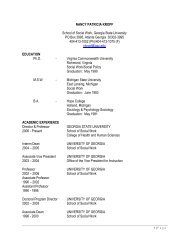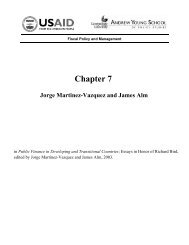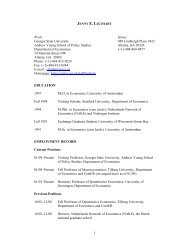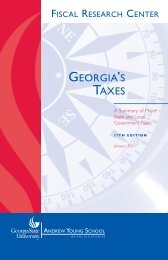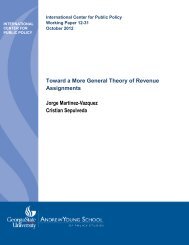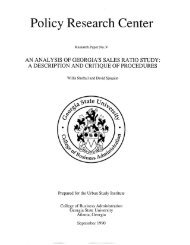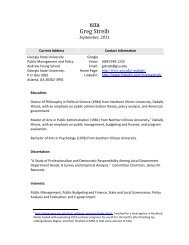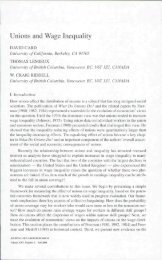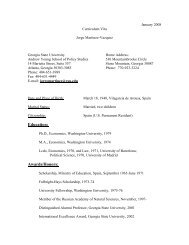Robin Boadway and Frank Flatters - Andrew Young School of Policy ...
Robin Boadway and Frank Flatters - Andrew Young School of Policy ...
Robin Boadway and Frank Flatters - Andrew Young School of Policy ...
You also want an ePaper? Increase the reach of your titles
YUMPU automatically turns print PDFs into web optimized ePapers that Google loves.
614 / <strong>Robin</strong> <strong>Boadway</strong> <strong>and</strong> <strong>Frank</strong> <strong>Flatters</strong><br />
INTRODUCTION<br />
Federal-provincial transfers aimed at redistributing income among provinces have<br />
been a long-st<strong>and</strong>ing fact <strong>of</strong> life <strong>and</strong> source <strong>of</strong> controversy in Canada. The main such<br />
program is the federal-provincial scheme <strong>of</strong> equalization payments, but there are<br />
other types <strong>of</strong> transfers between levels <strong>of</strong> government that have an implicit equalizing<br />
component (e.g., Established Programs Financing Grants).1 The question <strong>of</strong> the<br />
appropriate amount <strong>of</strong> equalization, if any, <strong>and</strong> the formula to be used have become<br />
matters <strong>of</strong> urgency for several reasons. The current equalization scheme falls due in<br />
1982 <strong>and</strong> the renegotiation is controversial for many reasons, including the close<br />
relationship between equalization payments <strong>and</strong> the disposal <strong>of</strong> the benefits <strong>of</strong> oil <strong>and</strong><br />
natural gas rewards.2 In addition, equalization has become a constitutional issue since<br />
the constitutional reform package embeds (albeit somewhat vaguely) the principle <strong>of</strong><br />
equalization into the constitution.3<br />
There is now a sizable literature on the economics <strong>of</strong> federal states, much <strong>of</strong> it<br />
directed rather abstractly to the issue <strong>of</strong> optimal resource allocation in federal<br />
economies. We would like to extend that literature by investigating the economic<br />
rationale for intergovernmental equalizing transfers in a federal economy. More<br />
specifically, this paper attempts to do three things. First, we present a synthesis <strong>of</strong> the<br />
existing results on fiscal federalism, showing in the framework <strong>of</strong> a simple model the<br />
sources <strong>of</strong> inefficiency <strong>of</strong> resource allocation stressed in a literature. Next, using the<br />
same model we extend the analysis to consider the role for intergovernmental<br />
transfers in the face <strong>of</strong> such inefficiencies. Finally, we briefly compare these policy<br />
implications with those derived from considerations <strong>of</strong> equity. Since the equity<br />
results have been discussed at considerable length elsewhere,4 there is no need to go<br />
into their derivation in this paper.<br />
Our analysis begins with the sorts <strong>of</strong> identical-person economies which have<br />
dominated the literature to date. Out <strong>of</strong> this will come a survey <strong>of</strong> the sorts <strong>of</strong><br />
inefficiencies <strong>of</strong> resource allocation that can occur in economies with multiple levels<br />
<strong>of</strong> government. These models will form a basis for a discussion <strong>of</strong> the role <strong>of</strong><br />
equalizing transfers on efficiency grounds. Subsequently, the discussion will be<br />
extended to economies <strong>of</strong> heterogeneous individuals in which equity as well as<br />
efficiency become relevant for policy issues. The analysis will be based upon<br />
simple abstract models designed to capture the basic forces at work. We believe that<br />
the general results are applicable in more complicated situations. Finally, we are<br />
1 The EPF grants provide equal per capita grants to the provinces financed out <strong>of</strong> federal general<br />
revenues <strong>and</strong> involve equalization to the extent that the base for federal tax collections is unevenly<br />
distributed over provinces. For a survey <strong>of</strong> existing federal-provincial transfer programs see<br />
<strong>Boadway</strong> (1980).<br />
2 This relationship is discussed in Courchene (1980) <strong>and</strong> Helliwell (1980).<br />
3 Also, see the Task Force on Canadian Unity (1979), the so-called Beige Paper <strong>of</strong> the Quebec Liberal<br />
Party (1980) <strong>and</strong> the Trudeau government's Charter <strong>of</strong> Rights (1981). There is a question as to<br />
whether, even if equalization turns out to be justified on economic grounds, it is an appropriate obligation<br />
to include the constitution (contrary views appear in <strong>Boadway</strong> <strong>and</strong> Norrie, 1980 <strong>and</strong> Usher,<br />
1981). We shall ignore that question.<br />
4 <strong>Boadway</strong> <strong>and</strong> <strong>Flatters</strong> (1982).



